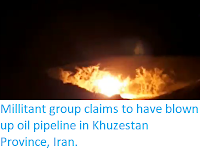Heavy rains have brought flooding to parts of southwestern Iran, southeastern Iraq, Kuwait and northeastern Saudi Arabia this week. Saudi Arabia has been the worst hit, with at least 35 killed in flash flooding incidents and 4000 being forced to evacuate their homes. The flooding has also killed at least 12 people in Iraq. Neither Iran not Kuwait have reported any casualties, but both countries have been forced to evacuate people from areas effected by the flooding.
Two Indian nationals trapped on top of a vehicle in the Al-Lith Valley in Saudi Arabia. Both were later rescued by the Royal Saudi Air Defence Forces. Al-Ekhbariya.
The Middle East, while generally arid, is prone to occasional severe flooding. This stems from two causes; firstly the arid climate prevents the development of a thick soil layer which would be expected in less dry areas, so that in much of the area (non-porous) bedrock is either exposed or close to the surface, and secondly the hot climate leads to heavy evaporation from nearby seas and oceans, so that if the wind changes direction and brings water-laden air to the area, it brings a lot of precipitation with it. This combination of heavy rainfall and low ground absorbency leads to large amounts of water at the surface, typically moving downhill at some speed. Wadis, dry channels or ravines through which these sudden floods are channelled, can be particularly dangerous at these times, particularly as they often appear to resemble natural pathways or even camp sites to people unfamiliar with the climate.
Another man being rescued from flooding in Makkah Province, Saudi Arabia, on Friday 23 November 2018. Saudi Gazzette.
The storms have been caused by a low pressure system over the western Persian Gulf, caused by exceptionally hot weather in the region. As the air is heated the the air pressure drops and the air rises, causing new air to rush in from outside the forming storm zone. If this zone is sufficiently large, then it will be influenced by the Coriolis Effect, which loosely speaking means the winds closer to the equator will be faster than those further away, causing the storm to rotate, clockwise in the northern hemisphere and anticlockwise in the southern hemisphere.
Rescue workers aiding flood victims in the Al-Shirqat District of Iraq on Friday 23 November 2018. Middle East Monitor.
Whilst the high winds associated these storms is extremely dangerous, the real danger from such storms is often the flooding. Each millibar drop in air pressure can lead to a 1 cm rise in sea level, and large storms can be accompanied by storm surges several meters high. This tends to be accompanied by high levels of rainfall, caused by water picked up by the storm while still at sea, which can lead to flooding, swollen rivers and landslides; which occur when waterlogged soils on hill slopes lose their cohesion and slump downwards, over whatever happens to be in their path.
Damage caused by flooding in Kuwait City earlier this month. Noufal Ibrahim/EPA.
This extreme weather is thought to be connected with a developing El Niño weather system, which warms the waters of the Arabian Sea and Persian Gulf. The El Niño is the warm phase of a long-term climatic oscillation affecting the southern Pacific, which can influence the climate around the world. The onset of El Niño conditions is marked by a sharp rise in temperature and pressure over the southern Indian Ocean, which then moves eastward over the southern Pacific. This pulls rainfall with it, leading to higher rainfall over the Pacific and lower rainfall over South Asia. This reduced rainfall during the already hot and dry summer leads to soaring temperatures in southern Asia, followed by a rise in rainfall that often causes flooding in the Americas and sometimes Africa. Worryingly climatic predictions for the next century suggest that global warming could lead to more frequent and severe El Niño conditions, extreme weather conditions a common occurrence.
Movements of air masses and changes in precipitation in an El Niño weather system. Fiona Martin/NOAA.
See also...
Follow Sciency Thoughts on Facebook.











